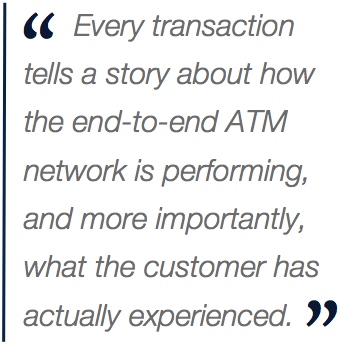


For an ATM operator concerned about profitability and the end-user experience, big data is a goldmine — if they can tap into it in a timely, cost-effective way.

by Stacy Gorkoff, VP of Marketing, Inetco Systems Ltd.
ATM availability strategies continue to evolve and expand, mostly driven by easier data retrieval and growing customer demands. Here is a brief description of where we have come from, and what opportunities lie ahead:
It used to be that the best way to gauge the performance of your ATM fleet was to monitor a device's uptime and downtime.
Although this is still important, many banks, credit unions and other ATM deployers have figured out that a 98 percent-plus availability rate does not necessarily mirror the rate of customer transactions completed.
For instance, if downtime occurs at a full-service ATM during a high-traffic time period, the impact on end customer experience and profitability will be greater than if the downtime had taken place at a lower traffic ATM during a less busy time period.
In this instance, monitoring availability alone means failing the customer.
Many ATM operators are investing in self-service initiatives such as branch transformation, more sophisticated ATMs, and payments infrastructure modernization.
New technologies and applications are allowing customers to initiate a broader range of complex service and cross-channel transactions that were typically handled by branch tellers and customer service representatives.
Examples of this include everything from check deposit, bill payment and account balance confirmation to for a mortgage, auto loan and credit card applications or the delivery of personalized offers and promotions.

Customers who are digitally minded love this growing convenience — as long as their interactions are successful and their value-added services are performing as expected.
This is why the ability to pull real-time transaction data off the wire is such a beautiful, evolutionary thing. Such data extends visibility beyond the ATM to reveal how networks, applications, hosts and third-party service providers are responding.
Every transaction tells a story about how the end-to-end ATM network is performing, and more importantly, what the customer has actually experienced.
Transaction data offers great opportunity for deployers looking to improve and redefine their ATM availability strategy.
Financial institutions that do track their customer interactions have reported, on average, 65–75 percent faster resolution of performance issues affecting transaction completion rates.
Many also have expanded their channel management performance metrics to include:
Growing digital transaction volumes are resulting in an explosion of ATM big data. For anyone concerned about profitability and the end-user experience, this data is a goldmine — if you can tap into it in a timely, cost-effective way.
A centralized data and monitoring hub instantly widens the value proposition of transaction data.
This system makes it simple and efficient — not only for the operations team, but also for the business side, including executives, channel managers, marketers and data analysts — to gain instant access to the intelligence they need to deliver more value to existing customers, to acquire new customers and to improve profitability through better ATM placement and service offerings.
Customer engagement analytics is all about putting a business lens on ATM big data.
This, in turn, can allow an organization to perform granular customer segmentation, understand customer use patterns by device or product, and analyze how customer experience and revenue are affected by transaction performance.
Using customer engagement analytics, an organization can perform predictive modeling to estimate waiting lines at service points, identify common interaction sequences and measure things such as cash flow movement.
Interactive reporting dashboards can help the ATM operator to adopt data-driven strategies around operations, utilization, channel performance and profitability.
Knowing ATM availability is a fine start. But it's only a start.
Tracking customer interactions and using transaction data for customer engagement analytics can help an organization to create an indispensable roadmap for refining channel management strategy and getting the most from ATM big data.
photo istock
Sign up now for the ATM Marketplace newsletter and get the top stories delivered straight to your inbox.
Privacy PolicySeptember 9-11, 2024 | Charlotte, NC